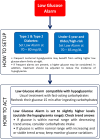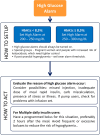Glucose alarms approach with flash glucose monitoring system: a narrative review of clinical benefits
- PMID: 40671052
- PMCID: PMC12269169
- DOI: 10.1186/s13098-025-01797-3
Glucose alarms approach with flash glucose monitoring system: a narrative review of clinical benefits
Abstract
Attaining an adequate glycemic control has been associated with a better prognosis and with a reduction in the risk of developing long-term microvascular and macrovascular diabetic complications. Continuous glucose monitoring (CGM) has been shown to improve glycemic control and reduce blood glucose variability. Furthermore, CGM is associated with greater treatment adherence and higher satisfaction. Hypoglycemia is the most frequent acute complication in individuals with insulin treated diabetes and may limit the achievement of glycemic control. Furthermore, repeated episodes of hypoglycemia, particularly when a severe hypoglycemia event occurs are associated with adverse outcomes. The introduction of glucose alarms improves not only safety of subjects, but also contributes to improve glycemic control. However, depending on the glycemic thresholds, the frequency of alarms could be perceived as excessive, leading to a state of 'alarm fatigue', limiting the effective response to the alarms by the individual. The optimization of alarm thresholds tailored to individual needs and preferences can enhance the clinical utility of CGM while minimizing alarm fatigue. When alarms occur, their underlying causes should be investigated to enable appropriate corrections and adjustments. CGM systems equipped with alarms, such as FreeStyle Libre 2, have demonstrated efficacy in reducing hyperglycemia and severe hypoglycemic events, leading to improvements in time in range and quality of life of people with diabetes.
Keywords: Diabetes; Flash continuous glucose monitoring; Glucose alarm; Hyperglycemia; Hypoglycemia.
© 2025. The Author(s).
Conflict of interest statement
Declarations. Ethics approval and consent to participate: Not applicable. Consent for publication: Not applicable. Competing interests: Marcio Krakauer has received support from Abbott, Roche, Novo, Lilly, Astra, Boehringer. Solange Travassos has received support from Medtronic, Abbott, Novo Nordisk, Astra Zeneca. Melanie Rodackie has received support from Abbott, NovoNordisk. Monica A. L. Gabbay has received support from Abbott, Medtronic, Roche, Sanofi. André Vianna has received support from Abbott, Medtronic, Roche, Novo Nordisk, Sanofi, Lilly, Astra Zeneca. Mauro Scharf has received support as member of advisory boards and/or speaker from Pfizer, Novonordisk, Sanofi, Medtronic, Abbott, Cristalia, Sandoz. He has received honoraria as medical consultant from Biomm Cristalia. He has recieved Travel Grants from Medtronic, Pfizer, Eli Lilly. He is owner of Stock Options from Endomed s/c, Intelmed s/c, G7med s/c, Centro de Diabetes Curitiba ltda, Unilabs AS. He is Technical Manager of Unimed Labs and Unigenne labs. Rodrigo N Lamounier has received support from Abbott, Eli-Lilly, Medtronic, Novo Nordisk. Denise Reis Franco has received support from Abbott, Lilly, Novo Nordisk, Sanofi, Medtronic. Levimar Rocha Araújo has received support from Abbott, Medtronic, Bioom. Luis Eduardo Calliari has received support from Abbott, NovoNordisk, Medtronic.
Figures



References
-
- Elgart JF, Gonzalez L, Prestes M, Rucci E, Gagliardino JJ. Frequency of self-monitoring blood glucose and attainment of HbA1c target values. Acta Diabetol 2016; Feb;53(1):57–62. 10.1007/s00592-015-0745-9. - PubMed
Publication types
LinkOut - more resources
Full Text Sources

